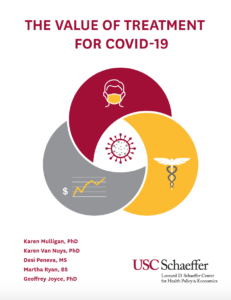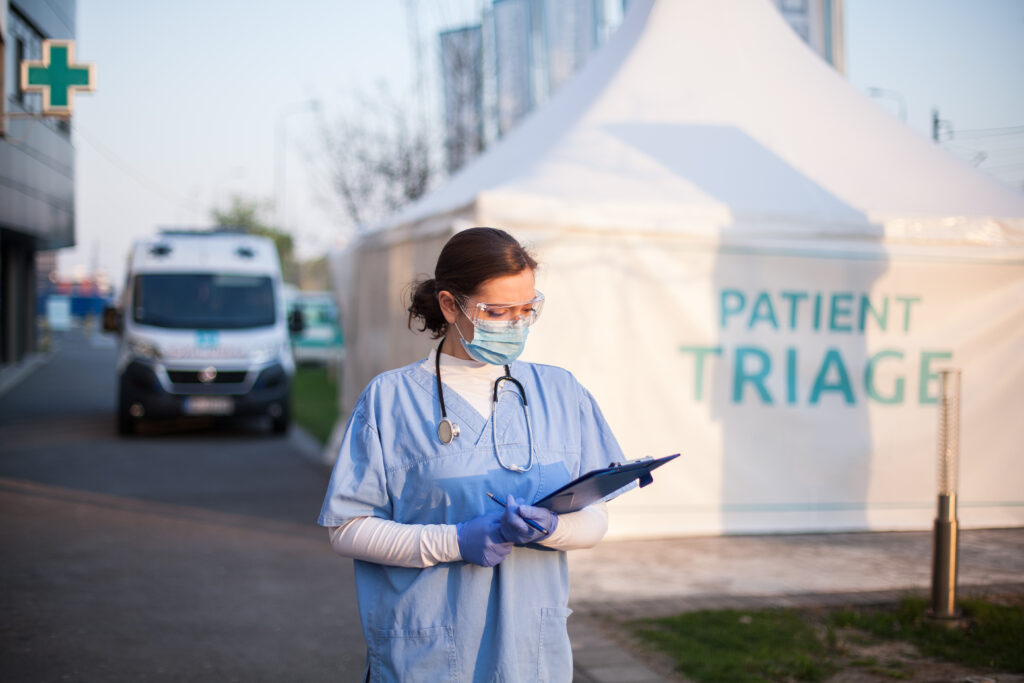Treatment for COVID-19 would deliver up to $106 billion in gains by the end of 2021 finds new USC Schaeffer Center analysis
As the COVID-19 pandemic continues to impact health and livelihoods of millions, there is increasing attention focused on vaccine development. But an effective treatment has a critical role to play – before and after a vaccine is developed – and has the potential to deliver tens of billions of dollars in gains.
 A new Schaeffer Center white paper models the value of two hypothetical treatments – one administered before patients require hospitalization and one administered in the hospital – to analyze the health-related value such treatments could provide.
A new Schaeffer Center white paper models the value of two hypothetical treatments – one administered before patients require hospitalization and one administered in the hospital – to analyze the health-related value such treatments could provide.
The researchers find both scenarios result in tens of thousands of lives saved and a significant reduction in hospital resource use. They estimate these health-related gains add up to between $57 billion and $106 billion in value over 18 months if 20% of the population becomes infected.
“Even after a vaccine for COVID-19 becomes available, there may be supply issues and it may not be effective across the entire population. Furthermore, some people may choose not to be vaccinated,” said Geoffrey Joyce, senior author on the study. “As such, developing effective treatments has to be a central part of any strategy if we are going to safely move towards reopening society.” Joyce is the director of health policy at the USC Schaeffer Center and an associate professor at the USC School of Pharmacy.
Modeling COVID-19 Treatment Benefits
The research team modeled three scenarios: a baseline where no treatment is available, and two scenarios in which patients receive a hypothetical therapy:
- Scenario 1 considers a hypothetical treatment taken outside the hospital setting. Modeled loosely after flu antiviral therapies such as Tamiflu (oseltamivir phosphate), it is administered to patients early in the course of the disease and reduces disease severity, hospitalization risk and, in turn, mortality.
- Scenario 2 considers a hypothetical treatment administered to patients in the hospital that reduces both length of hospital stays and mortality. It is modeled after therapies such as remdesivir and dexamethasone, which are administered in hospital settings to patients with more severe illness and have demonstrated therapeutic effect in randomized clinical trials.
To model these scenarios, a number of assumptions were made. Primarily, the researchers assumed 20% of the population becomes infected by the end of 2021, and hypothetical treatments become widely available in the second half of 2020.
The researchers found that the hypothetical treatment taken outside the hospital would reduce hospitalizations by 285,000 and deaths by up to 71,000 by the end of 2021. The hypothetical treatment administered in the hospital does not reduce hospitalizations but results in up to 85,000 fewer deaths.
“Given the uncertainty about how this disease behaves, we deliberately used conservative assumptions in our model. Even so, the value of treatment over just the next 18 months would be enormous and has the potential to help with hospital capacity constraints,” said Schaeffer Center Fellow and USC Price School of Public Policy Research Assistant Professor Karen Mulligan.
All in all, both treatments create tens of billions of dollars in gains over 18 months, with most gains coming from reduced mortality. The researchers estimate a total value of $57 billion to $88 billion for a treatment taken outside the hospital, and $68 billion to $106 billion for a treatment given to hospitalized patients.
Importantly, economic-related benefits, which would result if policies that have been implemented to curb the spread of the virus could be relaxed earlier or faster, were not directly modeled.
The Costs of COVID-19
The total costs of the COVID-19 pandemic are large and growing. In the U.S. alone, over 130,000 people have died, at least 17.8 million adults are unemployed, and the U.S. economy is predicted to shrink by almost $8 trillion over the next 10 years. The sharp increases in COVID-19 cases seen in recent weeks as economic restrictions are loosened highlight the tradeoff between economic activity and public health when the most effective response available is social distancing, hand washing, and mask wearing.
“While we didn’t directly model the economic value of a new treatment, we know the current costs to the economy are unprecedented. If a new treatment enables loosening of social mitigation policies and boosts citizens’ confidence in engaging in economic activities, the benefit could easily be as large or larger than the health impacts we model,” said Karen Van Nuys, who is the Executive Director of the Value of Life Sciences Initiative at the USC Schaeffer Center.
Given their findings and how quickly this virus has proven to spread, the researchers argue the federal response should prioritize the development of treatments alongside vaccines.
“The federal government has invested more than $4 billion in manufacturing vaccines that, as of yet, are unproven. In comparison, the federal investment in developing treatments is closer to $400 million,” said Joyce. “Having a vaccine is critical, but vaccines are rarely effective for everyone and it will be hard to achieve universal vaccination adherence, thus treatments that either reduce the likelihood of being hospitalized or the risk of dying would have enormous societal value before and after a vaccine is widely available.”
The authors acknowledge several limitations to the analysis, particularly those related to uncertainty surrounding key parameter values used to model the behavior of the virus, specifically the mortality rate. An appendix detailing the sensitivity analyses conducted to explore these limitations is available here.
This white paper was coauthored by Desi Peneva and Martha Ryan, in addition to Joyce, Mulligan, and Van Nuys. This research was funded by the USC Schaeffer Center for Health Policy & Economics, which receives support from a wide variety of public and private entities and donors, including companies developing vaccines and treatments for COVID-19.

You must be logged in to post a comment.